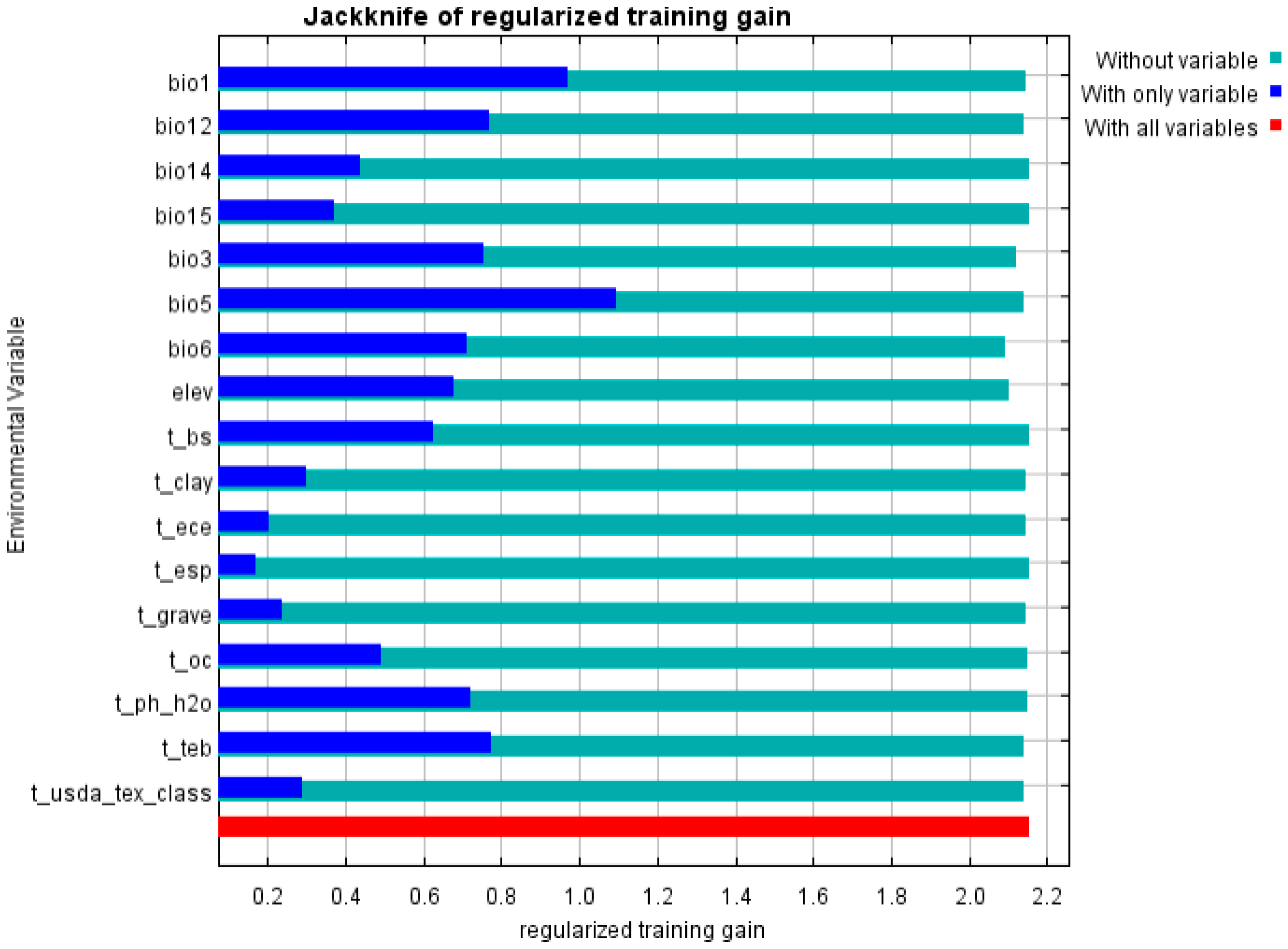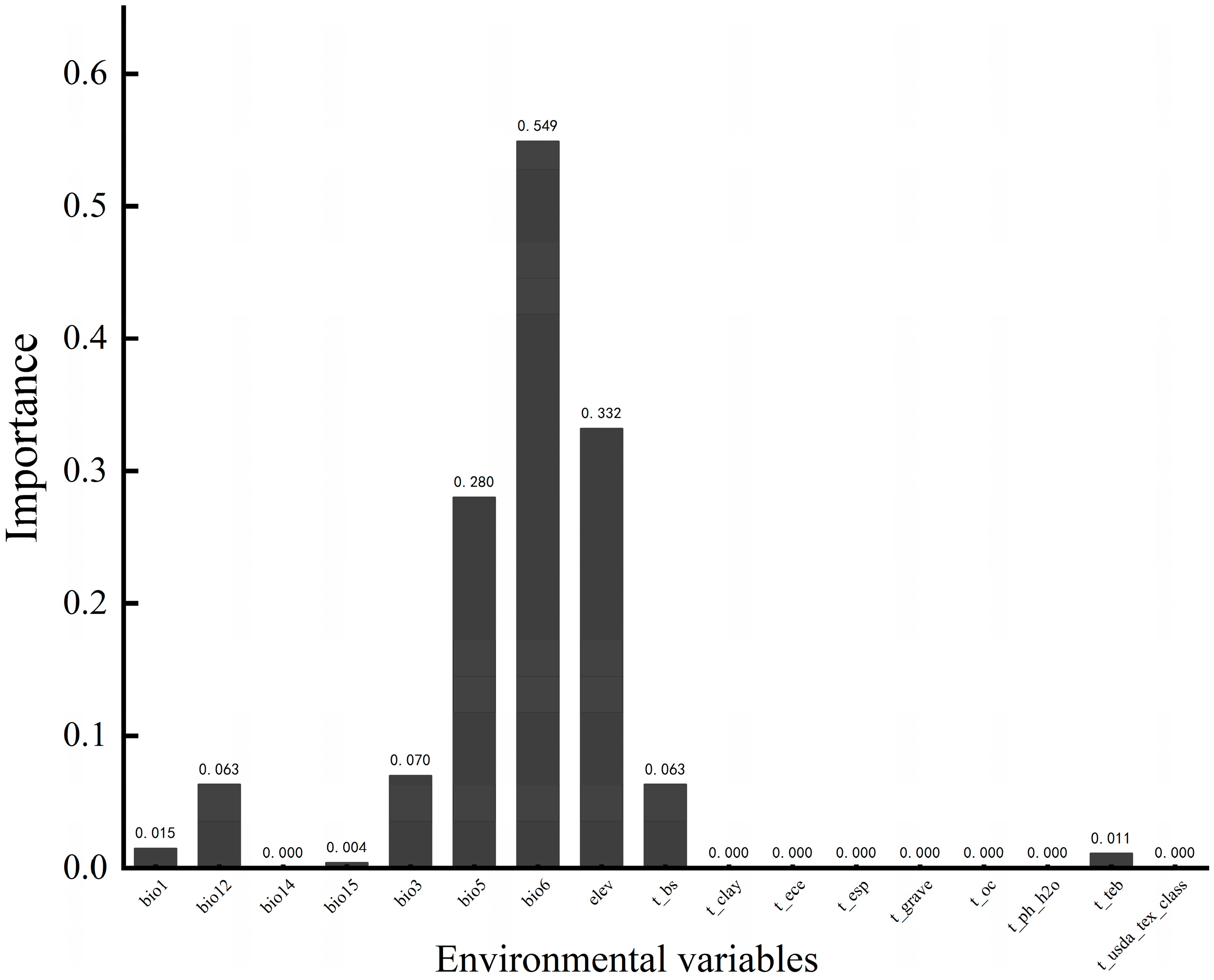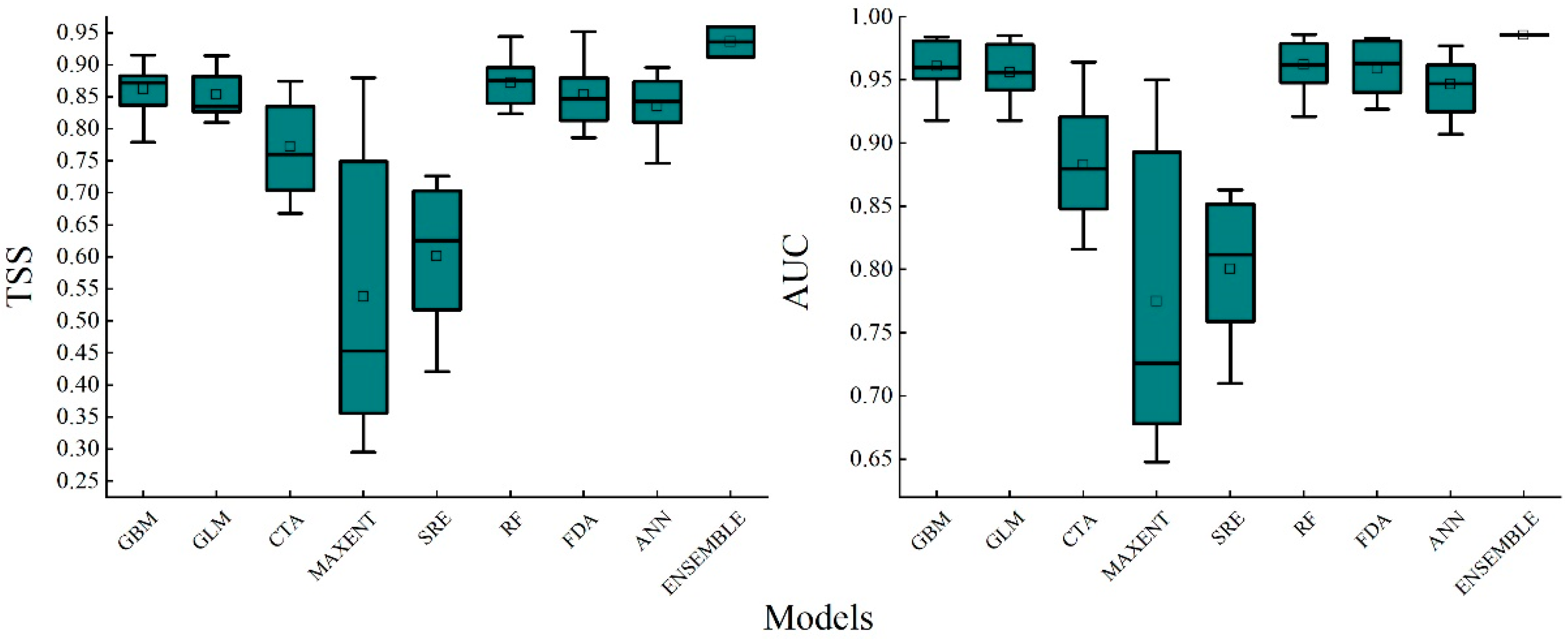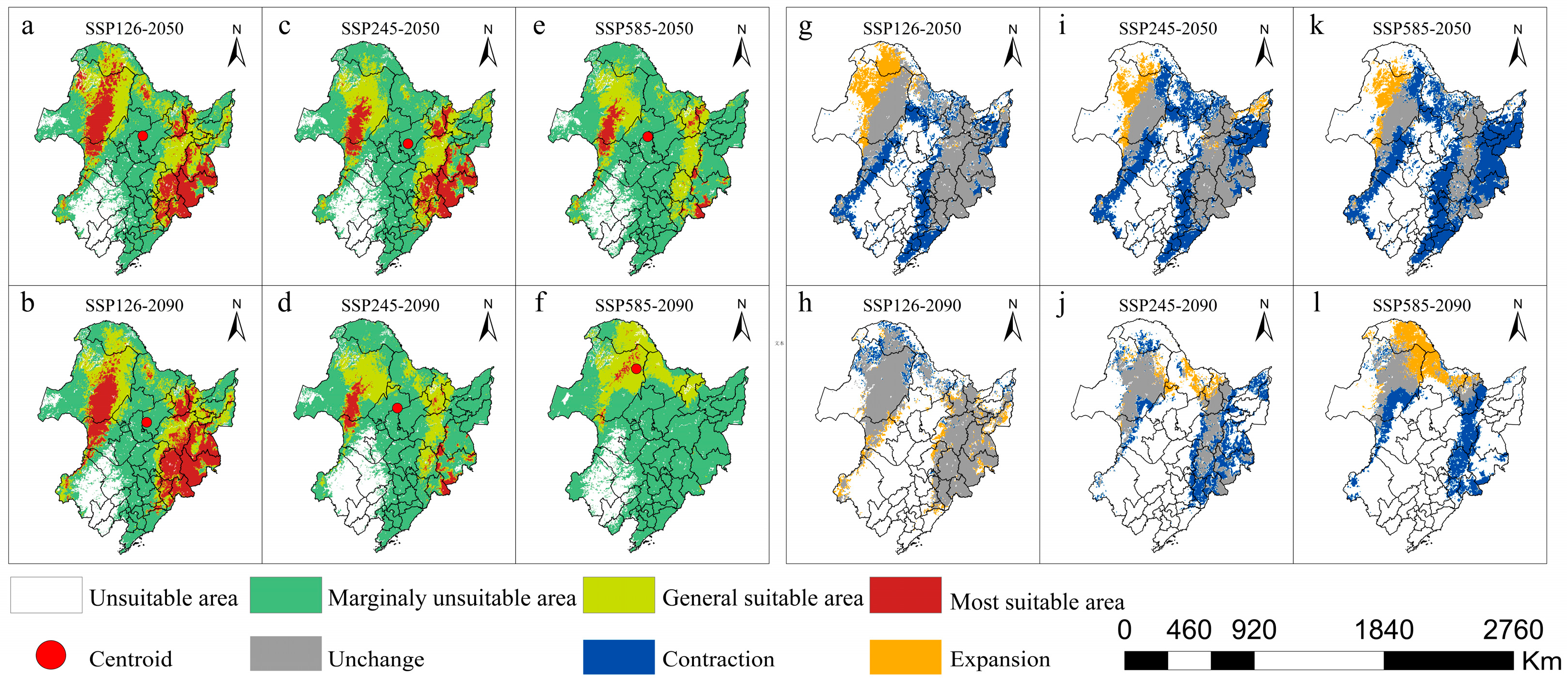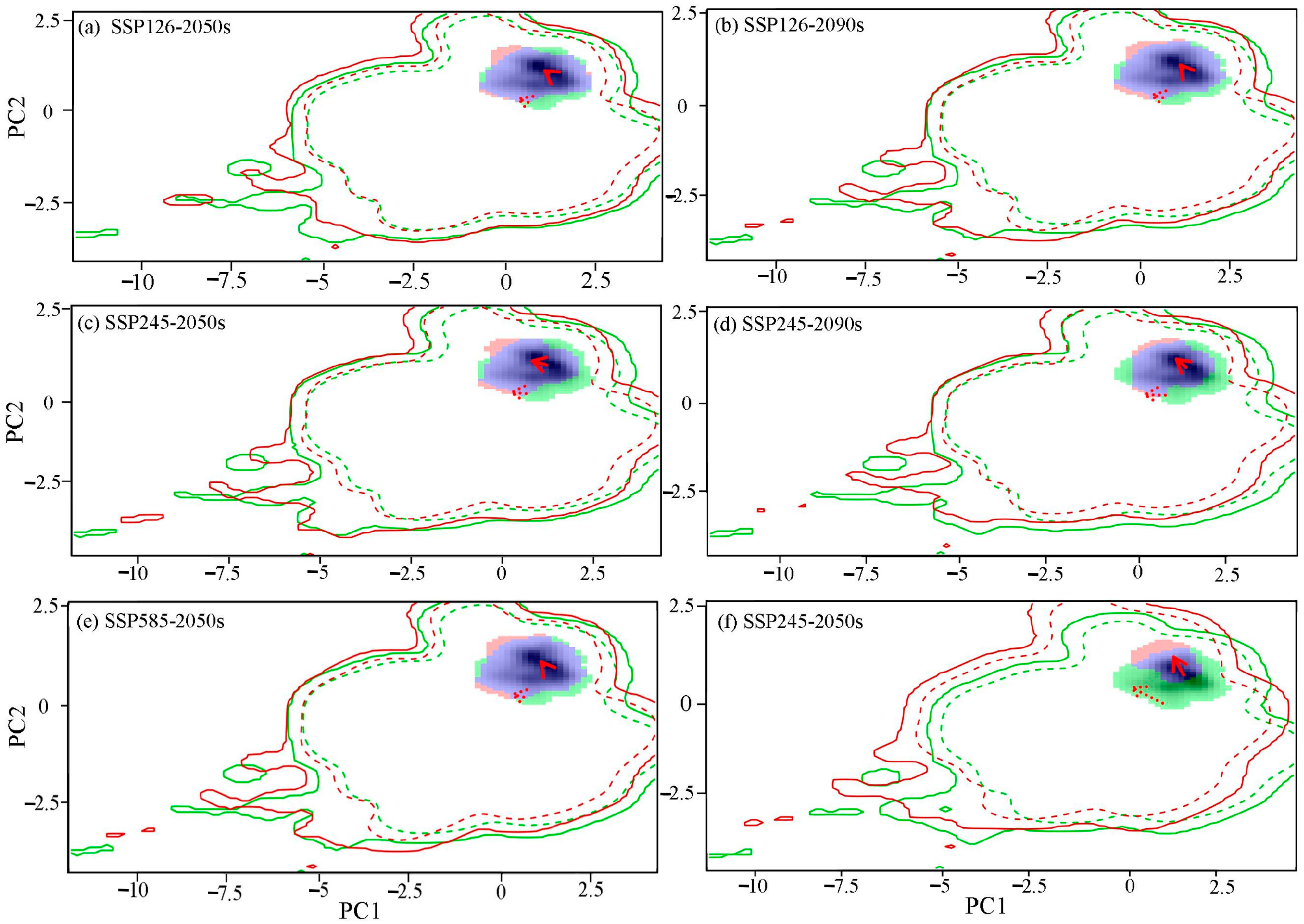1. Introduction
The Mongolian oak, scientifically designated as
Quercus mongolica Fisch.ex Ledeb., belongs to the Fagaceae family and the
Quercus genus. Predominantly found in northern and northeastern China, it stands as a pivotal secondary tree species in the Northeastern forest area. When the primeval forest is disrupted by fire or human activities,
Quercus mongolica showcases remarkable resilience and competitiveness due to its robust stress- tolerant growth characteristics. As a result, it thrives and evolves into a stable secondary
Q. mongolica forest, eventually emerging as the dominant species comprising the largest proportion of secondary broad-leaved forests [
1,
2]. In the forest region of northeast China,
Q. mongolica stands as a vital broad-leaved tree species, playing a pivotal role in indicating the extent of climatic warming and drying. Consequently, its response to climate change may significantly alter the species composition within this forest region [
3]. Therefore, this paper has chosen
Q. mongolica as the representative tree species of broad-leaved forests in northeast China for in-depth research.
Since the 20th century, the industrial boom has led to a significant increase in greenhouse gas emissions and global temperatures. Consequently, China’s climate and environment have undergone marked transformations, with a slightly higher rate of change than the global average during the same period [
4]. Climate warming has led to an increase in accumulated temperature, accelerating the onset of spring and delaying the arrival of autumn for trees, thereby extending their growing season. As a result, trees have more time to engage in photosynthesis and growth, bolstering their survival prospects within the region. Furthermore, climate change will alter rainfall patterns, causing varying degrees of changes in water and heat conditions across different regions. Consequently, suitable habitats for various species are experiencing expansion, contraction, and migration within these distinct regions. Research undertaken by Li Xiaoxia and her team reveals that the acceleration of spring growth and development intensifies competition between tree species, driving the alpine tree line to ascend towards higher elevations [
5]. Furthermore, Wang Qi and his colleagues have discovered that as temperatures continue to rise, the radial growth of the
Q. mongolica species in Beijing and Daheishan, Liaoning, is projected to decline by the end of this century, signifying that rising temperatures are already exerting a notable impact on the growth of
Q. mongolica, an effect that is anticipated to intensify amidst ongoing climatic shifts [
6]. By delving into how species have responded to climate change in the past and how they might in the future, we can gain a deeper understanding of the factors shaping species evolution and geographical dispersal. This knowledge, in turn, aids in formulating scientifically grounded strategies for managing germplasm resources.
A species distribution model (SDM) forecasts the potential range of a species in a given area by mapping its ecological requirements to specific future climatic conditions [
7,
8,
9]. With technological advancements in computers and statistics, numerous SDMs have been devised and implemented. The most prevalent models are the Maximum Entropy Model (MaxEnt) [
10], Random Forest (RF) [
11], Artificial Neural Network (ANN) [
12], Generalized Linear Model (GLM), Generalized Additive Model (GAM) [
13], Multiple Adaptive Regression Splines (MARS) [
14], Flexible Discriminant Analysis (FDA) [
15], Classification Tree Analysis (CTA) [
16], Surface Range Envelope Model (SRE) [
17], and Gradient Boosting Machine (GBM) [
18,
19,
20]. Each of these models operates under different principles and algorithms, and the choice of model often depends on the specific research objectives [
20]. To address the limitations of a single model, researchers are increasingly developing ensemble models. One such platform is Biomod2, built on the R language. It enhances the predictive accuracy of species distributions by assigning optimal weights to individual models within the ensemble, thus achieving a superior simulation effect [
21,
22,
23,
24,
25,
26,
27].
Research conducted in Northeast China has conclusively demonstrated that climate warming has significantly reshaped the geographical distribution patterns and altered the growth rhythms of both coniferous and broad-leaved trees [
3,
28]. Current scholarly endeavors predominantly concentrate on analyzing the effects of climate change on the growth and potential distribution patterns of coniferous species, exemplified by
Abies fabri (Mast.) Craib [
29],
Pinus massoniana Lamb. [
30],
Larix gmelinii (Rupr.) Kuzen. [
31], and
Pinus tabulaeformis Carrière [
32]. In contrast, research directed towards broad-leaved species remains relatively scarce, despite the notable potential for their suitable habitats to respond to climate change in fundamentally different ways compared to 100 coniferous species.
Q. mongolica, a prominent representative among the major broad-leaved tree species in Northeast China’s forests, holds paramount significance in exploring the intricacies of its response to climate change. Comprehending
Q. mongolica’s adaptation to shifting climatic conditions is vital for evaluating the potential spatial redistributions of key broadleaved tree species as they adapt to warming temperatures in these forests. Furthermore, such insights are crucial for developing a holistic understanding of the intricate interplay between forest ecosystems and climate change dynamics. Thus, this study aims to (1) forecast alterations in suitable habitats under varying climate scenarios, (2) identify key environmental factors that shape its distribution, and (3) analyze shifts in its ecological niches under diverse future climatic conditions. This will serve as a valuable resource for the conservation and sustainable management of
Q. mongolica populations.
2. Materials and Methods
2.1. Study Area
The Northeast region of China, encompassing latitudes 38°72′ to 53°56′ N and longitudes 115°52′ to 135°09′ E, is situated in the northeastern part of the mainland. It comprises the administrative territories of Heilongjiang, Jilin, and Liaoning provinces, as well as the eastern section of the Inner Mongolia Autonomous Region, particularly Hulunbuir City, Xing’an League, Tongliao City, and Chifeng City. The northeast region of China has a temperate monsoon climate, with a cold and long winter characterized by low average temperatures. In particular, the northern regions such as the Greater Khingan Range can experience temperatures below −40 °C during winter. Summer is warm but short, with average temperatures ranging from 20 °C to 24 °C in July. Annual precipitation falls between 300 and 1000 mm, concentrated primarily in summer, resulting in a coincidence of rainy and hot periods. The main forests in the northeastern region are distributed across the Greater Khingan Range, Lesser Khingan Range, and Changbai Mountain Range. The Greater Khingan Range runs in a north–east–southwest direction, with a terrain that slopes down from west to east and is relatively broad and gentle, providing ample space for forest growth. The Lesser Khingan Range follows a northwest–southeast orientation, featuring a low-lying and gently rolling terrain dominated by hills and low mountains with alternating valleys. The Changbai Mountain Range also extends in a northeast–southwest direction, with its main peak reaching significantly high altitudes and a notably rugged terrain. From the foothills to the summit, various vegetation zones are formed. Given the considerable variation in altitude, ranging from a few hundred meters to over two thousand meters, changes in natural conditions such as temperature, precipitation, and soil occur with increasing elevation, thereby influencing the vertical distribution of vegetation. The primary vegetation types include coniferous forests and mixed coniferous-broadleaved forests. Coniferous forests are dominated by species such as Dahurian larch and Korean pine, while broad leaved trees like Betula platyphylla Sukaczev and Q. mongolica contribute to the diverse vegetation types, including temperate mixed coniferous-broad-leaved forests, cold-temperate coniferous forests, warm-temperate deciduous broad-leaved forests, and temperate steppes.
2.2. Collection and Screening of Distribution Data
During the field investigation conducted between 2017 and 2021, we leveraged the data from the China Digital Herbarium (CVH), the National Herbarium of China (NSII), the Global Biodiversity Information Network Platform (GBIF), and other relevant public sources. This comprehensive effort resulted in the collection of 174 sample points for
Q. mongolica. To refine the retrieved information on
Q. mongolica, it is crucial to eliminate specimens lacking images, those with questionable status, duplicate entries, vague details, and incorrect identifications. Subsequently, accurately recorded data points containing longitude and latitude coordinates for
Q. mongolica have been extracted and neatly stored in an Excel 2019 file, formatted as a .csv document. To mitigate spatial auto correlation among the species’ distribution points, we utilize the Python (v.3.11)-based GIS toolkit, SDM toolbox [
33], to further filter the distribution data with clear geographic coordinates. This process ensures that within a 1 km radius, only a single representative data point is retained, eliminating redundancies. Ultimately, this meticulous process yields 144 valid sampling sites, ready for modeling and analysis (
Figure 1).
2.3. Acquisition and Processing of Environment Variables
In this research, a total of 14 topsoil data points, 1 topographic data point, and 19 bioclimatic factors were chosen as potential environmental variables for modeling. The soil and topographic data originate from the World Soil Database (
www.fao.org, accessed on 10 February 2024), while the bioclimatic factors are sourced from the World Climate Database (
www.worldclim.org). Utilizing the BCC-CSM2-MR global climate model, we selected three climate scenarios, SSP126, SSP245, and SSP585, for two distinct periods: 2022–2060 (2050s) and 2061–2100 (2090s). The map data include a Chinese standard map, procured from the standard map service website (
http://bzdt.ch.mnr.gov.cn/, 10 February 2024) of the National Administration of Surveying, Mapping, and Geoinformation, with a drawing review number of GS (2019) No. 1698.
To ensure the integrity and reliability of the data, we conducted a variance inflation factor (VIF) test and a Pearson correlation test on each environmental factor using the “usdm” package in R 4.2.0 software and used the jackknife test to assess the relative importance of each variable (
Figure A1), and then determined the dominant environmental factors based on their contribution rates. Based on the relative importance of each variable (
Figure A1) and then criteria of VIF < 10 and r < 0.8 [
34,
35], we narrowed down the variables to 9 soil factors, 7 climatic factors, and 1 topographic factor for subsequent modeling (
Table A1).
2.4. Model Building and Testing
This study utilized the Biomod2 package in the R language to model the distribution area of Q. mongolica. Eight diverse modeling techniques were utilized, specifically Gradient Boosting Regression Tree (GBM), Generalized Linear Model (GLM), Classification and Regression Tree (CART), Maximum Entropy Modeling (MaxEnt), Surface Range Envelope (SRE), Random Forest (RF), Flexible Discriminant Analysis (FDA), and Artificial Neural Network (ANN). Among these, the MaxEnt model was configured with a modulation frequency doubling parameter (RM) of 0.5 and a feature combination of LQ, while the remaining seven models adhered to the default model parameters provided by Biomod2. For model development, 75% of the distribution point data were randomly sampled to constitute the training dataset, reserving the remaining 25% for testing. Additionally, 1440 pseudo-absence points were randomly generated to enhance the modeling process, fulfilling the Biomod2 modeling prerequisites and simulating real-world distribution patterns more accurately.
To assess the predictive accuracy of each individual model, we employed receiver operating characteristic curves (ROCs) and true skill statistics (TSS) [
36,
37]. Specifically, the area under the ROC curve (AUC) was utilized as a metric, ranging from 0.5 to 1, with higher values indicating superior predictive performance. An AUC value exceeding 0.8 signifies excellent or very good prediction accuracy [
38], while values below 0.7 indicate poor performance. The TSS value, ranging from 0 to 1, signifies the net predictive success rate achieved on the measured samples. A TSS value exceeding 0.7 denotes a high level of accuracy in model predictions, whereas a value below 0.5 suggests poor model accuracy. Based on the AUC and TSS scores, the five models with the highest values were selected for ensemble modeling. The weight assigned to each model in the ensemble was determined proportionally to its TSS evaluation score.
2.5. Niche Change Analysis
By utilizing ArcGIS 10.4.1, we meticulously extracted the climate data associated with each background point, encompassing a range of diverse climatic conditions. Subsequently, we processed these data through the comprehensive “ecospat” software package for a detailed analysis. The primary objective is to quantify the overlap between the current ecological niche of
Q. mongolica and its projected future niche under various climate scenarios. This assessment aims to provide insight into the precise impacts of climate change on the ecological niche of
Q. mongolica, enabling informed decision making and conservation strategies [
39]. Presently, the selection area for background points of
Q. mongolica is defined by the distribution points and a buffer distance of 1 degree. The ensemble model’s predicted suitable area serves as the backdrop for future background point selection across varying climatic settings. The overlap index D quantifies the extent of niche overlap between species. Specifically, a D value of 0 signifies no overlap, while a D of 1 indicates complete overlap [
40].
2.6. Data Analysis and Processing
ArcGIS 10.4.1 is utilized to transform the outcomes of the model. To categorize these results, we employ the natural breaks method [
41,
42], which divides the gradient of suitable habitats into four distinct grades: highly suitable (1–0.5), generally suitable (0.5–0.3), less suitable (0.3–0.1), and non-suitable (0.1–0). Utilizing the ArcGIS 10.4.1 software, we mapped the future spatial distribution patterns of
Q. mongolica under varying climate change scenarios, tracking the geospatial changes in suitable and non-suitable areas across different time periods. This allowed us to calculate the corresponding area changes. Additionally, we marked the centroid positions of Mongolian oak’s suitable habitat during two time periods under diverse climatic backgrounds, determined the centroid migration direction, and calculated the centroid migration distance employing Matlab 2016 software.
4. Discussion
Utilizing data on the actual geographical distribution and ecological factors of Q. mongolica, we employed the Biomod2 platform integrated with ArcGIS spatial analysis to delve into the potential suitable habitats for Q. mongolica under current climatic conditions. This approach further allowed us to foresee the future changes in the distribution range and center of these potential habitats within China. During model selection, the RF, GBM, FDA, GLM, and ANN models exhibited superior predictive accuracy. Notably, the combined accuracy of these five individual models far surpassed any single model, achieving AUC and TSS values of 0.985 and 0.936, respectively, thereby enhancing our capacity to predict the distribution and shifts of Q. mongolica.
Climatic factors like temperature extremes, topographical variables, human interventions, and spatial limitations each exert varying degrees of influence on the dispersal of
Q. mongolica [
43]. The results of rigorous model screening indicate that the peak temperature in the hottest month, the nadir temperature in the coldest month, and altitude are the chief determinants of suitable habitats.
Q. mongolica thrives best in regions located below 1500 m above sea level. The rise in altitude has a direct impact on temperature, resulting in a decrease in both temperature and oxygen content as one ascends. When the altitude becomes excessively high, these cumulative environmental alterations surpass the adaptability threshold of
Q. mongolica, ultimately affecting its growth and distribution patterns. It is crucial for the hottest month of the growing season to maintain a maximum temperature below 30 °C. Should this threshold be surpassed, the respiratory rate of
Q. mongolica intensifies, leading to an excessive consumption of photosynthetic products. Concurrently, this exacerbates transpiration, potentially causing excessive water loss in the trees and subsequently compromising their growth rate and overall health [
44]. Additionally, the minimum temperature in the coldest month should fall between −15 °C and −31 °C; deviations from this range may pose risks of dendromancy or frost damage to the Mongolian oak. The predicted potential distribution area and its primary influencing factors align closely with past records in the academic literature [
43,
45], thereby further authenticating the precision of our combined modeling approach. Notably, the nine soil factors evaluated in this study exhibited negligible impact on the growth and dispersal of
Q. mongolica, suggesting that this species does not harbor stringent requirements for soil conditions and possesses a broad adaptability range.
Under the varying climatic scenarios of SSP126, SSP245, and SSP585,
Q. mongolica exhibited varying degrees of potential habitat loss. Specifically, under the SSP126 scenario, the total suitable area for
Q. mongolica initially decreased but subsequently increased. This shift was attributed to significant changes in the average hottest month’s temperature (bio5) in low latitudes during the 2050s, which propelled the suitable habitat northward. However, by the 2090s, there was no significant variation in the average hottest month’s maximum temperature (bio5). Existing studies indicate that as global warming persists, precipitation patterns in Northeast China are anticipated to undergo significant fluctuations, accompanied by an increase in extreme precipitation events [
46]. This excessive precipitation may counteract the northward shift caused by the rising temperature in the hottest month, thereby contributing to the expansion of
Q. mongolica’s suitable habitat in low latitudes during the 2090s. According to current projections under the three climate scenarios (SSP126, SSP245, SSP585), the total habitat loss of
Q. mongolica is predicted to be 45%, 76%, and 91% by 2100, respectively. In the event of a climate change trajectory exceeding the severity of the SSP585 scenario, it is expected that the suitable habitat for
Q. mongolica will gradually diminish in northern China.
This study employed the ecospat software to delve into the niche characteristics of
Q. mongolica across various climatic settings, both presently and in the future. A notable observation was the diminishing overlap between the present and predicted niche spaces for
Q. mongolica as climate change intensifies. This trend suggests that the climatic niche will evolve in response to changing environmental conditions. Among the scenarios considered, SSP585 represented the most severe climate scenario, with the lowest niche overlap. In this setting,
Q. mongolica is predicted to encroach on niches occupied by species residing at higher altitudes and latitudes, while its original niche may be usurped by species at lower altitudes. Upon studying the response of fir trees to projected continuous warming in the future, Tang and his team discovered that the climatic niche of these trees underwent shifts and expansions at distinct timepoints, contingent upon various representative concentration pathways. Notably, their analysis revealed a persistent downward trajectory in the niche overlap index, with the most pronounced decrement in niche overlap observed under the RCP8.5 scenario. This observation aligns well with the findings of our own research endeavors [
47]. The principal component analysis (PCA) indicates that temperature emerges as the primary driver of niche changes in
Q. mongolica, and if climate warming persists or intensifies, the species’ ecological niche could become completely distinct from its current one. Some research indicates that as global warming intensifies, species will migrate towards higher latitudes or altitudes as a coping mechanism against the adverse effects of climate change [
48]. In our current study, the predicted suitable habitat of
Q. mongolica is already concentrated in elevated areas, suggesting that further migration to higher altitudes may not be sufficient to mitigate the impacts of warming. Instead,
Q. mongolica is more inclined to migrate towards higher latitudes. Concurring with our findings, Du Bingyun et al. conducted a prediction of
Q. mongolica’s suitable habitat in the Greater Khingan Range under various climate scenarios and observed that the area of suitable habitat would expand under future climate conditions [
49]. This aligns with our conclusion that the northward shift of
Q. mongolica’s suitable habitat contributes to an increase in its range within the Greater Khingan Range. However, on a broader scale, across the entire Northeast China region, this northward migration results in a decrease in the southern range, ultimately leading to an overall reduction in the total suitable habitat area.
Across the three future climate scenarios simulated in this study, as climate change intensifies, the area of suitable habitats for Q. mongolica exhibited a diminishing trend, accompanied by a shift in the centroid towards higher latitudes. Interestingly, under the SSP126 climate scenario, the suitable habitat area for Q. mongolica slightly expanded in the 2090s compared to the 2050s. This particular trend signifies that Q. mongolica has a degree of resilience against climate change, suggesting that a moderate increase in warmth and humidity can aid in the expansion of its optimal habitats. Conversely, a more significant reduction in the suitable habitat area and a more distant migration of the distribution center towards higher latitudes are indicative of a more significant impact of climate change. It is worth noting that the phased climate change parameters employed in this study did not precisely determine the extent to which Q. mongolica responds to climate warming.
As global warming intensifies, the distribution range of Q. mongolica in China is narrowing, posing a threat of extinction. A comprehensive understanding of this species’ changing distribution patterns is essential for conserving Q. mongolica resources and fostering responsible introduction and cultivation practices. To mitigate the decline of Q. mongolica in China, we must prioritize the protection of existing highly suitable habitats. This involves enhancing in situ conservation efforts, manually intervening to correct unreasonable stand structures, and initiating ecological introduction and restoration measures. Enhancements can be achieved through the following strategic measures: (1) Conducting exhaustive research into the ecological behaviors, physiological traits, and adaptive responses of Q. mongolica to climatic variations will furnish a robust scientific foundation for devising more targeted and efficacious conservation plans. This will ensure our strategies are grounded in empirical knowledge. (2) Establishing perpetual monitoring stations within current and potential habitats suitable for Q. mongolica is imperative. These stations should continuously track environmental variables, encompassing temperature, precipitation patterns, and soil conditions. By harnessing advanced information technologies, such as remote sensing and Geographic Information Systems (GIS), we can analyze and manage the monitoring data with precision, enabling swift comprehension of dynamic shifts in habitat suitability for Q. mongolica. (3) Within the pivotal distribution zones of Q. mongolica, the designation of nature reserves or conservation areas is an urgent priority. Stringent regulations must be enforced to restrict human activities, outlawing detrimental practices like unlawful logging, land reclamation, and grazing. This safeguard ensures that the delicate ecosystem supporting Q. mongolica remains undisturbed. (4) Prompt rehabilitation efforts are vital in addressing habitat destruction inflicted by human activities or natural disasters. For instance, damaged forest areas should undergo reforestation, prioritizing the selection of compatible tree species for mixed plantings with Q. mongolica. This approach facilitates the restoration of the forest ecosystem’s structural integrity and functional capabilities. (5) Reinforcing the investigation and application of artificial propagation techniques for Q. mongolica is crucial. Large-scale cultivation of Q. mongolica seedlings must be undertaken utilizing diverse methods like seed propagation, cuttings, and tissue culture. Establishing a dedicated Q. mongolica seedling nursery will ensure an ample supply of seedlings for future planting endeavors and population relocation projects.
5. Conclusions
This study has developed a robust combined model, integrating Random Forest (RF), Gradient Boosting Machine (GBM), Functional Data Analysis (FDA), Generalized Linear Model (GLM), and Artificial Neural Network (ANN), to precisely predict the distribution of potentially suitable habitats for Q. mongolica. The model exhibits remarkable fitting accuracy. Presently, highly suitable habitats for Q. mongolica are concentrated along the Daxing’an Mountains, Zhangguangcai Mountains, Changbai Mountains, and coastal regions. Moderately suitable areas are situated in the transitional zone between forests and grasslands, adjacent to these highly favorable locations.
Among various environmental factors, key determinants of Q. mongolica’s habitat distribution includes the hottest month’s temperature, the highest temperature, the coldest month’s temperature, the lowest temperature, and altitude. As we brace for global warming in the 21st century, the potential habitat of the Mongolian oak may shift northward. Consequently, climate change is expected to result in the loss of habitats in coastal watersheds and low-latitude regions in Northeast China. Under three distinct climate scenarios, the projected habitat loss for Q. mongolica is anticipated to range between 45% and 91% by 2090. To address this pressing issue, it is imperative to strengthen the conservation efforts for existing Mongolian oak resources in highly suitable habitats. Additionally, manual interventions should be implemented to address unfavorable stand structures, and ecological introductions and restoration measures must be undertaken to mitigate the impact of climate change on this important species.
